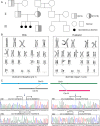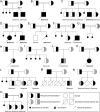Successful birth after preimplantation genetic testing for a couple with two different reciprocal translocations and review of the literature
- PMID: 33879178
- PMCID: PMC8056626
- DOI: 10.1186/s12958-021-00731-2
Successful birth after preimplantation genetic testing for a couple with two different reciprocal translocations and review of the literature
Abstract
Background: Preimplantation genetic testing for chromosomal structural rearrangements (PGT-SR) is widely applied in couples with single reciprocal translocation to increase the chance for a healthy live birth. However, limited knowledge is known on the data of PGT-SR when both parents have a reciprocal translocation. Here, we for the first time present a rare instance of PGT-SR for a non-consanguineous couple in which both parents carried an independent balanced reciprocal translocation and show how relevant genetic counseling data can be generated.
Methods: The precise translocation breakpoints were identified by whole genome low-coverage sequencing (WGLCS) and Sanger sequencing. Next-generation sequencing (NGS) combining with breakpoint-specific polymerase chain reaction (PCR) was used to define 24-chromosome and the carrier status of the euploid embryos.
Results: Surprisingly, 2 out of 3 day-5 blastocysts were found to be balanced for maternal reciprocal translocation while being normal for paternal translocation and thus transferable. The transferable embryo rate was significantly higher than that which would be expected theoretically. Transfer of one balanced embryo resulted in the birth of a healthy boy.
Conclusion(s): Our data of PGT-SR together with a systematic review of the literature should help in providing couples carrying two different reciprocal translocations undergoing PGT-SR with more appropriate genetic counseling.
Keywords: Genetic counseling; PGT-SR; Reciprocal translocations; Translocation breakpoints; Whole genome low-coverage sequencing.
Conflict of interest statement
The authors declare that they have no competing interests.
Figures



Similar articles
-
PGT-SR (reciprocal translocation) using trophectoderm sampling and next-generation sequencing: insights from a virtual trial.J Assist Reprod Genet. 2021 Aug;38(8):1971-1978. doi: 10.1007/s10815-021-02174-5. Epub 2021 Mar 27. J Assist Reprod Genet. 2021. PMID: 33774740 Free PMC article.
-
Evaluation of chromosomal abnormalities from preimplantation genetic testing to the reproductive outcomes: a comparison between three different structural rearrangements based on next-generation sequencing.J Assist Reprod Genet. 2021 Mar;38(3):709-718. doi: 10.1007/s10815-020-02053-5. Epub 2021 Jan 6. J Assist Reprod Genet. 2021. PMID: 33409753 Free PMC article.
-
Preferential selection and transfer of euploid noncarrier embryos in preimplantation genetic diagnosis cycles for reciprocal translocations.Fertil Steril. 2017 Oct;108(4):620-627.e4. doi: 10.1016/j.fertnstert.2017.07.010. Epub 2017 Aug 30. Fertil Steril. 2017. PMID: 28863935
-
Should every embryo undergo preimplantation genetic testing for aneuploidy? A review of the modern approach to in vitro fertilization.Best Pract Res Clin Obstet Gynaecol. 2018 Nov;53:38-47. doi: 10.1016/j.bpobgyn.2018.07.005. Epub 2018 Jul 25. Best Pract Res Clin Obstet Gynaecol. 2018. PMID: 30146380 Review.
-
Impact of preimplantation genetic testing on obstetric and neonatal outcomes: a systematic review and meta-analysis.Fertil Steril. 2021 Oct;116(4):990-1000. doi: 10.1016/j.fertnstert.2021.06.040. Epub 2021 Aug 7. Fertil Steril. 2021. PMID: 34373103
Cited by
-
Uniparental disomy (UPD) exclusion in embryos following Preimplantation Genetic Testing for Structural Rearrangements (PGT-SR).J Assist Reprod Genet. 2025 Jan;42(1):265-273. doi: 10.1007/s10815-024-03352-x. Epub 2024 Dec 18. J Assist Reprod Genet. 2025. PMID: 39693035
-
Preimplantation genetic testing for complex chromosomal rearrangements: clinical outcomes and potential risk factors.Front Genet. 2024 Jul 29;15:1401549. doi: 10.3389/fgene.2024.1401549. eCollection 2024. Front Genet. 2024. PMID: 39139821 Free PMC article.
References
-
- De Krom G, Arens YH, Coonen E, Van Ravenswaaij-Arts CM, Meijer-Hoogeveen M, Evers JL, et al. Recurrent miscarriage in translocation carriers: no differences in clinical characteristics between couples who accept and couples who decline PGD. Hum Reprod. 2015;30(2):484–489. doi: 10.1093/humrep/deu314. - DOI - PubMed
-
- Lim CK, Cho JW, Song IO, Kang IS, Yoon YD, Jun JH. Estimation of chromosomal imbalances in preimplantation embryos from preimplantation genetic diagnosis cycles of reciprocal translocations with or without acrocentric chromosomes. Fertil Steril. 2008;90(6):2144–2151. doi: 10.1016/j.fertnstert.2007.10.035. - DOI - PubMed
Publication types
MeSH terms
Grants and funding
LinkOut - more resources
Full Text Sources
Other Literature Sources
Medical
Research Materials

